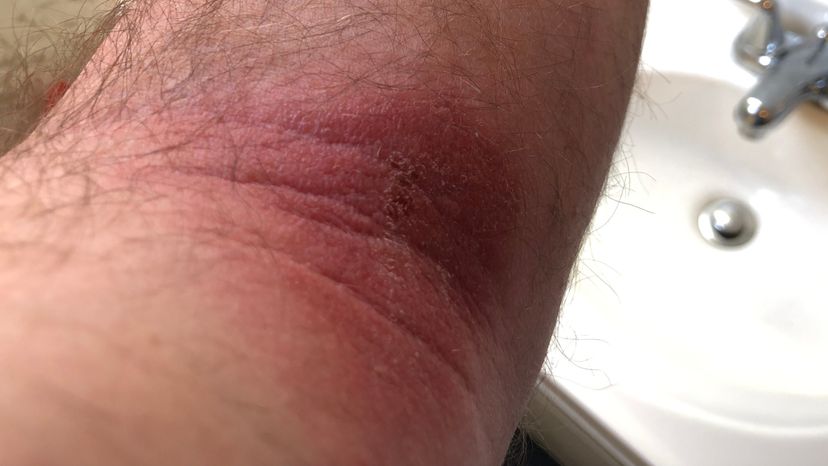
Contact with poison ivy, poison oak, or poison sumac often goes hand-in-hand with camping and other outdoor activities. Outdoor enthusiasts by the tentful have had to cut trips short after an unfortunate encounter with one of this threesome.
The problem stems from the plant's colorless oil called urushiol. Whenever one of these plants is cut, crushed, stepped on, sat on, grabbed, rolled on, kicked, or disturbed, the oil is released. It oozes from any cut or crushed part of the leaves or stem, so just brushing a plant may not elicit a reaction. Oil content in the plants runs highest in the spring and summer, but cases are reported even in the dead of winter.
Advertisement
Once on the victim, the toxic oil penetrates the skin and a rash appears within 12 to 48 hours after exposure. This is a true allergic reaction to compounds in the urushiol. The rash starts as small bumps and progresses into enlarged, itchy blisters. No body part is immune to the oil, although areas most often irritated are the face, arms, hands, legs, and genitals.
Poison ivy, oak and sumac are uncomfortable plants to come into contact with, but there are ways to calm the itchy rash that they can cause. In fact, a number of simple home remedies exist. In this article, we'll discuss 17 ways to prevent getting a rash from poison ivy, oak or sumac and how to treat such a rash, using medicines and common household items, if one should occur. But first, let's take a look at what these plants are and where they are.
Poison ivy, oak, and sumac are hardy weeds that can be found throughout the United States, except in Hawaii, Alaska, and some desert areas of Nevada. Poison ivy is found east of the Rockies, poison oak grows in the West and Southwest, and poison sumac thrives east of the Mississippi River. All three produce similar reactions, and if you're allergic to one, you'll probably react to the others as well.
Cases of poison ivy, oak, and sumac affect 10 to 50 million people in the United States each year. In fact, these plants constitute the single most common cause of allergic reactions. A lucky 10 to 15 percent of Americans don't react to these plants, but another 10 to 15 percent are quite sensitive to them. The rest of us fall somewhere in between, with varying levels of sensitivity.
What muddies the waters is that a person's sensitivity can change over time, even from season to season. You could be quite sensitive to poison ivy as a child but seem immune to the weed as an adult. Or you may not have your first bad reaction to one of these poisonous plants until late in life, though sensitivity tends to decline with age.
Your level of sensitivity determines how bad a reaction you'll have. Once the oil touches the skin, it starts to penetrate in minutes. Within 12 to 48 hours, the red, itchy rash appears, followed by blisters that may weep and later get crusty. The area usually heals in about ten days. Among the very sensitive population, affected areas of skin will quickly swell up, the rash can be severe and painful, and the reaction may take up to three weeks to clear if left untreated. If you are highly sensitive to these plants, see a doctor as soon as you come in contact with one.
Even for people who are only mildly sensitive, a rash from poison ivy, oak, or sumac is no fun. The itching can drive you absolutely crazy. You try to ignore it, but you can't. All you want to do is scratch like a maniac. It's almost enough to make you want to give up going outside ever again.
Fortunately, you don't have to. You simply need to know how to take steps to avoid these foes and what to do to get relief if your preventive steps fail. There are a number of home remedies that can help ease the discomfort of plant-induced itching. See the next section for some tips to prevent the problem in the first place.
For more information about allergies and skin ailments and how to treat them, try the following links:
- To see our home remedies for food poisoning, go to our Home Remedies for Food Poisoning page.
- If you want to learn more about allergies, try the How Allergies Work page.
- Dealing with a more heated skin situation? Read our Home Remedies for Sunburn article.
This information is solely for informational purposes. IT IS NOT INTENDED TO PROVIDE MEDICAL ADVICE. Neither the Editors of Consumer Guide (R), Publications International, Ltd., the author nor publisher take responsibility for any possible consequences from any treatment, procedure, exercise, dietary modification, action or application of medication which results from reading or following the information contained in this information. The publication of this information does not constitute the practice of medicine, and this information does not replace the advice of your physician or other health care provider. Before undertaking any course of treatment, the reader must seek the advice of their physician or other health care provider.
Advertisement

